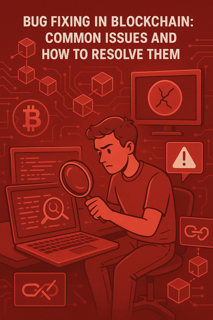Bug Fixing in Blockchain is Common Issues and How to Resolve Them?

Blockchain technology has earned a reputation for security and reliability, but like any software, it isn’t immune to bugs. Even a minor error in blockchain code can cause major disruptions—ranging from transaction failures to vulnerabilities that can be exploited by attackers.
In the fast-moving world of blockchain development, understanding common bugs and knowing how to fix them is essential for maintaining network integrity.
Understanding the Nature of Blockchain Bugs
Unlike traditional applications, blockchain systems are decentralized. This means that once code is deployed—especially in smart contracts—it’s often immutable. Any bugs in the deployed code can’t simply be “patched” without careful planning. Because blockchains handle sensitive transactions and valuable digital assets, the stakes are much higher than in regular software projects.
Common Blockchain Bugs and Their Causes
1. Smart Contract Vulnerabilities
Smart contracts are self-executing programs on the blockchain. Common issues include:
Reentrancy attacks – where malicious contracts repeatedly call a function before the first execution completes.
Integer overflow/underflow – arithmetic errors that change token balances.
Unrestricted access control – missing authentication checks in functions.
Cause: Insufficient validation, lack of code auditing, or rushed deployment.
2. Consensus Mechanism Errors
The consensus algorithm (e.g., Proof of Work, Proof of Stake) ensures all nodes agree on the blockchain state.
Bugs here may cause:
Forks or chain splits.
Delays in transaction confirmation.
Double-spending vulnerabilities.
Cause: Incorrect algorithm implementation or node synchronization issues.
3. Transaction Ordering Dependencies
Some smart contracts behave differently depending on the order of transactions in a block. Attackers can exploit this by influencing transaction sequencing (front-running).
Cause: Poorly designed logic that assumes a fixed transaction order.
4. Gas Limit and Out-of-Gas Errors
When executing smart contracts, exceeding the gas limit causes the transaction to fail, potentially locking tokens or halting execution.
Cause: Inefficient loops, unnecessary computations, or unoptimized contract code.
5. Cross-Chain Communication Bugs
As more projects use multiple blockchains, cross-chain bridges become a target for bugs and exploits.
Common issues:
Mismatched validation rules.
Incomplete state synchronization.
Improper message passing.
Cause: Inadequate protocol testing and complex interoperability requirements.
How to Fix Blockchain Bugs Effectively
1. Conduct Thorough Code Reviews
Peer reviews help identify issues that automated tools might miss. In blockchain development, reviews should focus on:
Smart contract logic.
Access control rules.
Edge cases and unexpected inputs.
2. Use Static and Dynamic Analysis Tools
Static analysis tools like Slither or Mythril can scan smart contracts for known vulnerabilities.
Dynamic analysis tools simulate contract execution to detect runtime issues.
3. Implement a Multi-Stage Testing Process
Unit testing – Test individual functions in isolation.
Integration testing – Ensure different components work together.
Testnet deployment – Deploy to a blockchain test network before going live.
4. Add Failsafes and Upgradeability
Consider designing smart contracts with upgrade mechanisms like proxy contracts.
Failsafes, such as circuit breakers, can pause contract activity if abnormal behavior is detected.
5. Audit Before Deployment
External audits by specialized blockchain security teams are critical. They provide an independent review and stress-test the system against potential attack vectors.
6. Bug Bounty Programs
Encouraging ethical hackers to find bugs can reveal vulnerabilities before malicious actors do.
Rewards motivate more thorough testing by the global developer community.
Best Practices for Preventing Bugs in Blockchain Development
Follow secure coding standards – Especially for Solidity, Rust, or Go (common blockchain languages).
Keep dependencies updated – Outdated libraries may contain known exploits.
Document code thoroughly – Clear documentation reduces misinterpretation during future updates.
Stay informed on industry vulnerabilities – Learn from past incidents like the DAO hack or Poly Network exploit.
Final Thoughts
Blockchain technology is powerful but unforgiving when it comes to mistakes. Once deployed, errors in smart contracts or consensus logic can lead to irreversible losses. By understanding the most common blockchain bugs and following a disciplined approach to testing and review, developers can reduce risks significantly.
Bug fixing in blockchain development isn’t just about repairing errors—it’s about building systems resilient enough to prevent them in the first place.
Kaizen Globalさんをフォローして最新の投稿をチェックしよう!
0 件のコメント
この投稿にコメントしよう!
この投稿にはまだコメントがありません。
ぜひあなたの声を聞かせてください。
